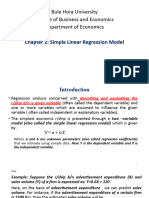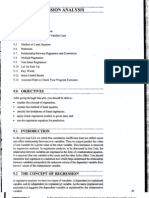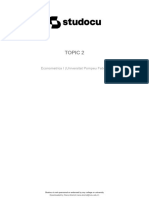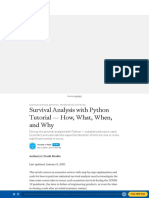measurement error edit_removed
Uploaded by
ankushstatsdumeasurement error edit_removed
Uploaded by
ankushstatsduChapter 16
Measurement Error Models
A fundamental assumption in all the statistical analysis is that all the observations are correctly measured. In
the context of multiple regression model, it is assumed that the observations on the study and explanatory
variables are observed without any error. In many situations, this basic assumption is violated. There can be
several reasons for such a violation.
For example, the variables may not be measurable, e.g., taste, climatic conditions, intelligence,
education, ability etc. In such cases, the dummy variables are used, and the observations can be
recorded in terms of values of dummy variables.
Sometimes the variables are clearly defined, but it is hard to take correct observations. For example,
the age is generally reported in complete years or in multiple of five.
Sometimes the variable is conceptually well defined, but it is not possible to take a correct
observation on it. Instead, the observations are obtained on closely related proxy variables, e.g., the
level of education is measured by the number of years of schooling.
Sometimes the variable is well understood, but it is qualitative in nature. For example, intelligence is
measured by intelligence quotient (IQ) scores.
In all such cases, the true value of the variable can not be recorded. Instead, it is observed with some error.
The difference between the observed and true values of the variable is called as measurement error or
errors-in-variables.
Difference between disturbances and measurement errors:
The disturbances in the linear regression model arise due to factors like the unpredictable element of
randomness, lack of deterministic relationship, measurement error in study variable etc. The disturbance
term is generally thought of as representing the influence of various explanatory variables that have not
actually been included in the relation. The measurement errors arise due to the use of an imperfect measure
of true variables.
Econometrics | Chapter 16 | Measurement Error Models | Shalabh, IIT Kanpur
1
Large and small measurement errors
If the magnitude of measurement errors is small, then they can be assumed to be merged in the disturbance
term, and they will not affect the statistical inferences much. On the other hand, if they are large in
magnitude, then they will lead to incorrect and invalid statistical inferences. For example, in the context of
linear regression model, the ordinary least squares estimator (OLSE) is the best linear unbiased estimator of
the regression coefficient when measurement errors are absent. When the measurement errors are present in
the data, the same OLSE becomes biased as well as inconsistent estimator of regression coefficients.
Consequences of measurement errors:
We first describe the measurement error model. Let the true relationship between correctly observed study
and explanatory variables be
y X
where y is a n 1 vector of true observation on study variable, X is a n k matrix of true observations
on explanatory variables and is a k 1 vector of regression coefficients. The value y and X are not
observable due to the presence of measurement errors. Instead, the values of y and X are observed with
additive measurement errors as
y y u
X X V
where y is a n 1 vector of observed values of study variables which are observed with (n 1)
measurement error vector u . Similarly, X is a (n k ) matrix of observed values of explanatory variables
which are observed with n k matrix V of measurement errors in X . In such a case, the usual disturbance
term can be assumed to be subsumed in u without loss of generality. Since our aim is to see the impact of
measurement errors, so it is not considered separately in the present case.
Alternatively, the same setup can be expressed as
y X u
X X V
where it can be assumed that only X is measured with measurement errors V and u can be considered as the
usual disturbance term in the model.
Econometrics | Chapter 16 | Measurement Error Models | Shalabh, IIT Kanpur
2
In case, some of the explanatory variables are measured without any measurement error then the
corresponding values in V will be set to zero.
We assume that
E (u ) 0, E (uu ') 2 I
E (V ) 0, E (V 'V ) , E (V ' u ) 0.
The following set of equations describes the measurement error model
y X
y y u
X X V
which can be re-expressed as
y y u
X u
X V u
X u V
=X
where u V is called as the composite disturbance term. This model resemble like a usual linear
regression model. A basic assumption in linear regression model is that the explanatory variables and
disturbances are uncorrelated. Let us verify this assumption in the model y X w as follows:
E X E ( X ) ' E ( ) E V '(u V )
E V ' u E V 'V
0
0.
Thus X and are correlated. So OLS will not provide efficient result.
Suppose we ignore the measurement errors and obtain the OLSE. Note that ignoring the measurement errors
in the data does not mean that they are not present. We now observe the properties of such an OLSE under
the setup of measurement error model.
Econometrics | Chapter 16 | Measurement Error Models | Shalabh, IIT Kanpur
3
The OLSE is
b X 'X X 'y
1
b X ' X X ' X
1
X ' X X '
1
E b E X ' X X '
1
X ' X X ' E ( )
1
0
as X is a random matrix which is correlated with . So b becomes a biased estimator of .
Now we check the consistency property of OLSE. Assume
1
plim X ' X xx
n
1
plim V 'V vv
n
1
plim X 'V 0
n
1
plim V ' u 0.
n
Then
X ' X 1 X '
plim b plim
n n
1 1
n
X ' X X V ' X V
n
1 1 1 1
X ' X X 'V V ' X V 'V
n n n n
1 1 1 1 1
plim X ' X plim X ' X plim X 'V plim V ' X plim V 'V
n n n n n
xx 0 0 vv
xx vv
1 1 1
X ' X ' V '
n n n
1 1
X '(u V ) V '(u V )
n n
Econometrics | Chapter 16 | Measurement Error Models | Shalabh, IIT Kanpur
4
1 1 1 1 1
plim X ' plim X ' u plim X 'V plim V ' u plim V 'V
n n n n n
0 0 0 vv
-1
X 'X X '
plim b plim plim
n n
xx vv vv
1
0.
Thus b is an inconsistent estimator of . Such inconsistency arises essentially due to correlation between
X and .
Note: It should not be misunderstood that the OLSE b X ' X X ' y is obtained by minimizing
1
S ' y X ' y X in the model y X . In fact ' cannot be minimized as in the case of
usual linear regression, because the composite error u V is itself a function of .
To see the nature of consistency, consider the simple linear regression model with measurement error as
yi 0 1 xi , i 1, 2,..., n
yi yi ui
xi xi vi .
Now
1 x1 1 x1 0 v1
1 x2 1 x2 0 v2
X , X , V
1 xn 1 xn 0 vn
and assuming that
1 n
plim xi
n i 1
1 n
plim ( xi ) 2 x2 ,
n i 1
we have
Econometrics | Chapter 16 | Measurement Error Models | Shalabh, IIT Kanpur
5
1
xx plim X ' X
n
1 n
1 xi
n i 1
plim n
1 1 n 2
xi xi
n i 1 n i 1
1
2
.
x
2
Also,
1
vv plim V 'V
n
0 0
2
.
0 v
Now
plim b xx vv vv
1
1
b 0 1 0 0 0
plim 0 2 2
b1 1 x v 0 v 1
2 2
1 x2 2 v2 0
2
x v2 2
1 v
v2
2 1
v x2
.
2
2 v 2 1
x v
Thus we find that the OLSEs of 0 and 1 are biased and inconsistent. So if a variable is subjected to
measurement errors, it not only affects its own parameter estimate but also affect other estimator of
parameter that are associated with those variable which are measured without any error. So the presence of
measurement errors in even a single variable not only makes the OLSE of its own parameter inconsistent but
also makes the estimates of other regression coefficients inconsistent which are measured without any error.
Econometrics | Chapter 16 | Measurement Error Models | Shalabh, IIT Kanpur
6
Forms of measurement error model:
Based on the assumption about the true values of the explanatory variable, there are three forms of
measurement error model .
Consider the model
yi 0 1 xi , i 1, 2,..., n
yi yi ui
xi xi vi .
1. Functional form: When the xi ' s are unknown constants (fixed), then the measurement error model is
said to be in its functional form.
2. Structural form: When the xi ' s are identically and independently distributed random variables, say, with
mean and variance 2 2 0 , the measurement error model is said to be in the structural form.
Note that in case of functional form, 2 0.
3. Ultrastructural form: When the xi ' s are independently distributed random variables with different
means, say i and variance 2 2 0 , then the model is said to be in the ultrastructural form. This form is
a synthesis of function and structural forms in the sense that both the forms are particular cases of
ultrastructural form.
Methods for consistent estimation of :
The OLSE of which is the best linear unbiased estimator becomes biased and inconsistent in the presence
of measurement errors. An important objective in measurement error models is how to obtain the consistent
estimators of regression coefficients. The instrumental variable estimation and method of maximum
likelihood (or method of moments) are utilized to obtain the consistent estimates of the parameters.
Econometrics | Chapter 16 | Measurement Error Models | Shalabh, IIT Kanpur
7
You might also like
- Hourglass Workout Program by Luisagiuliet 276% (21)Hourglass Workout Program by Luisagiuliet 251 pages
- The Hold Me Tight Workbook - Dr. Sue Johnson100% (16)The Hold Me Tight Workbook - Dr. Sue Johnson187 pages
- Read People Like A Book by Patrick King-Edited62% (65)Read People Like A Book by Patrick King-Edited12 pages
- Livingood, Blake - Livingood Daily Your 21-Day Guide To Experience Real Health77% (13)Livingood, Blake - Livingood Daily Your 21-Day Guide To Experience Real Health260 pages
- COSMIC CONSCIOUSNESS OF HUMANITY - PROBLEMS OF NEW COSMOGONY (V.P.Kaznacheev,. Л. V. Trofimov.)94% (212)COSMIC CONSCIOUSNESS OF HUMANITY - PROBLEMS OF NEW COSMOGONY (V.P.Kaznacheev,. Л. V. Trofimov.)212 pages
- Donald Trump & Jeffrey Epstein Rape Lawsuit and Affidavits83% (1016)Donald Trump & Jeffrey Epstein Rape Lawsuit and Affidavits13 pages
- The 36 Questions That Lead To Love - The New York Times94% (34)The 36 Questions That Lead To Love - The New York Times3 pages
- The 36 Questions That Lead To Love - The New York Times95% (21)The 36 Questions That Lead To Love - The New York Times3 pages
- Jeffrey Epstein39s Little Black Book Unredacted PDF75% (12)Jeffrey Epstein39s Little Black Book Unredacted PDF95 pages
- The 4 Hour Workweek, Expanded and Updated by Timothy Ferriss - Excerpt23% (954)The 4 Hour Workweek, Expanded and Updated by Timothy Ferriss - Excerpt38 pages
- Lecture Note 6 Asymptotic Properties PDFNo ratings yetLecture Note 6 Asymptotic Properties PDF4 pages
- Signed Off Statistics and Probability11 q2 m3 Random Sampling and Sampling Distribution v3 Pages Deleted56% (9)Signed Off Statistics and Probability11 q2 m3 Random Sampling and Sampling Distribution v3 Pages Deleted52 pages
- Chapter16 Econometrics Measurement Error ModelsNo ratings yetChapter16 Econometrics Measurement Error Models21 pages
- Chapter15 Econometrics InstrumentalVariableNo ratings yetChapter15 Econometrics InstrumentalVariable5 pages
- Theme 2 Ordinary Least Squares RegressionNo ratings yetTheme 2 Ordinary Least Squares Regression10 pages
- Chapter7 Econometrics MulticollinearityNo ratings yetChapter7 Econometrics Multicollinearity25 pages
- Briefly Discuss The Concept of LR AnalysisNo ratings yetBriefly Discuss The Concept of LR Analysis9 pages
- Regression Analysis - Chapter 4 - Model Adequacy Checking - Shalabh, IIT KanpurNo ratings yetRegression Analysis - Chapter 4 - Model Adequacy Checking - Shalabh, IIT Kanpur36 pages
- Regression With One Regressor-Hypothesis Tests and Confidence Intervals100% (1)Regression With One Regressor-Hypothesis Tests and Confidence Intervals53 pages
- Complete Business Statistics: Simple Linear Regression and CorrelationNo ratings yetComplete Business Statistics: Simple Linear Regression and Correlation50 pages
- Using Propensity Score Analysis in Behavioral Studies: Jie Chen, Ph.D. University of Massachusetts BostonNo ratings yetUsing Propensity Score Analysis in Behavioral Studies: Jie Chen, Ph.D. University of Massachusetts Boston58 pages
- Chapter 1 - Second-Order Tests of The Assumptions of The Linear Regression ModelNo ratings yetChapter 1 - Second-Order Tests of The Assumptions of The Linear Regression Model12 pages
- Asymtotic Prop of Estimators, Plims and ConsitencyNo ratings yetAsymtotic Prop of Estimators, Plims and Consitency50 pages
- Logit and Probit: Models With Discrete Dependent VariablesNo ratings yetLogit and Probit: Models With Discrete Dependent Variables30 pages
- Chapter 4 - THE SIMPLE LINEAR REGRESSION MODEL - OLS METHODNo ratings yetChapter 4 - THE SIMPLE LINEAR REGRESSION MODEL - OLS METHOD12 pages
- 14.382 Inference: Creative Commons BY-NC-SANo ratings yet14.382 Inference: Creative Commons BY-NC-SA19 pages
- Module III (Part II)(Regression and Time Series)No ratings yetModule III (Part II)(Regression and Time Series)118 pages
- slidesgo-navigating-the-storm-reflecting-on-student-stress-experiences-20250113181701kykwNo ratings yetslidesgo-navigating-the-storm-reflecting-on-student-stress-experiences-20250113181701kykw7 pages
- To formulate frequency table and draw cluster and stacked bar diagNo ratings yetTo formulate frequency table and draw cluster and stacked bar diag4 pages
- Introduction To Machine Learning: ETH Zurich Janik Schuettler Marcel Graetz FS18No ratings yetIntroduction To Machine Learning: ETH Zurich Janik Schuettler Marcel Graetz FS1818 pages
- Basic Statistics: B.A. Programme (Geography) Semester - IV Practical - II (GGB-08)No ratings yetBasic Statistics: B.A. Programme (Geography) Semester - IV Practical - II (GGB-08)13 pages
- IE325 Recitation 5-Spring 2020-SolutionsNo ratings yetIE325 Recitation 5-Spring 2020-Solutions17 pages
- EC221: Principles of Econometrics Introducing Lent: DR M. SchafgansNo ratings yetEC221: Principles of Econometrics Introducing Lent: DR M. Schafgans518 pages
- Survival Analysis With Python Tutorial - How, What, When, and Why - by Towards AI Team - Towards AINo ratings yetSurvival Analysis With Python Tutorial - How, What, When, and Why - by Towards AI Team - Towards AI44 pages
- Tukey Kramer Multiple Comparisons Sample Sample Group Mean Size Comparison 1 Group 1 To Group 2 2 Group 1 To Group 3 3 Group 2 To Group 3No ratings yetTukey Kramer Multiple Comparisons Sample Sample Group Mean Size Comparison 1 Group 1 To Group 2 2 Group 1 To Group 3 3 Group 2 To Group 313 pages
- Genetic Algorithms, Tournament Selection, and The Eects of NoiseNo ratings yetGenetic Algorithms, Tournament Selection, and The Eects of Noise14 pages
- Lab 01 - Scientific Method and Statistics (New Version)0% (1)Lab 01 - Scientific Method and Statistics (New Version)25 pages
- L09 Measurement Uncertainty in Microbiological Examinations of Foods Technique For Determination of Pathogens - Hilde Skår NorliNo ratings yetL09 Measurement Uncertainty in Microbiological Examinations of Foods Technique For Determination of Pathogens - Hilde Skår Norli20 pages
- Livingood, Blake - Livingood Daily Your 21-Day Guide To Experience Real HealthLivingood, Blake - Livingood Daily Your 21-Day Guide To Experience Real Health
- COSMIC CONSCIOUSNESS OF HUMANITY - PROBLEMS OF NEW COSMOGONY (V.P.Kaznacheev,. Л. V. Trofimov.)COSMIC CONSCIOUSNESS OF HUMANITY - PROBLEMS OF NEW COSMOGONY (V.P.Kaznacheev,. Л. V. Trofimov.)
- Donald Trump & Jeffrey Epstein Rape Lawsuit and AffidavitsDonald Trump & Jeffrey Epstein Rape Lawsuit and Affidavits
- The 36 Questions That Lead To Love - The New York TimesThe 36 Questions That Lead To Love - The New York Times
- The 36 Questions That Lead To Love - The New York TimesThe 36 Questions That Lead To Love - The New York Times
- Jeffrey Epstein39s Little Black Book Unredacted PDFJeffrey Epstein39s Little Black Book Unredacted PDF
- The 4 Hour Workweek, Expanded and Updated by Timothy Ferriss - ExcerptThe 4 Hour Workweek, Expanded and Updated by Timothy Ferriss - Excerpt
- Signed Off Statistics and Probability11 q2 m3 Random Sampling and Sampling Distribution v3 Pages DeletedSigned Off Statistics and Probability11 q2 m3 Random Sampling and Sampling Distribution v3 Pages Deleted
- Regression Analysis - Chapter 4 - Model Adequacy Checking - Shalabh, IIT KanpurRegression Analysis - Chapter 4 - Model Adequacy Checking - Shalabh, IIT Kanpur
- Regression With One Regressor-Hypothesis Tests and Confidence IntervalsRegression With One Regressor-Hypothesis Tests and Confidence Intervals
- Complete Business Statistics: Simple Linear Regression and CorrelationComplete Business Statistics: Simple Linear Regression and Correlation
- Using Propensity Score Analysis in Behavioral Studies: Jie Chen, Ph.D. University of Massachusetts BostonUsing Propensity Score Analysis in Behavioral Studies: Jie Chen, Ph.D. University of Massachusetts Boston
- Chapter 1 - Second-Order Tests of The Assumptions of The Linear Regression ModelChapter 1 - Second-Order Tests of The Assumptions of The Linear Regression Model
- Asymtotic Prop of Estimators, Plims and ConsitencyAsymtotic Prop of Estimators, Plims and Consitency
- Logit and Probit: Models With Discrete Dependent VariablesLogit and Probit: Models With Discrete Dependent Variables
- Chapter 4 - THE SIMPLE LINEAR REGRESSION MODEL - OLS METHODChapter 4 - THE SIMPLE LINEAR REGRESSION MODEL - OLS METHOD
- slidesgo-navigating-the-storm-reflecting-on-student-stress-experiences-20250113181701kykwslidesgo-navigating-the-storm-reflecting-on-student-stress-experiences-20250113181701kykw
- To formulate frequency table and draw cluster and stacked bar diagTo formulate frequency table and draw cluster and stacked bar diag
- Introduction To Machine Learning: ETH Zurich Janik Schuettler Marcel Graetz FS18Introduction To Machine Learning: ETH Zurich Janik Schuettler Marcel Graetz FS18
- Basic Statistics: B.A. Programme (Geography) Semester - IV Practical - II (GGB-08)Basic Statistics: B.A. Programme (Geography) Semester - IV Practical - II (GGB-08)
- EC221: Principles of Econometrics Introducing Lent: DR M. SchafgansEC221: Principles of Econometrics Introducing Lent: DR M. Schafgans
- Survival Analysis With Python Tutorial - How, What, When, and Why - by Towards AI Team - Towards AISurvival Analysis With Python Tutorial - How, What, When, and Why - by Towards AI Team - Towards AI
- Tukey Kramer Multiple Comparisons Sample Sample Group Mean Size Comparison 1 Group 1 To Group 2 2 Group 1 To Group 3 3 Group 2 To Group 3Tukey Kramer Multiple Comparisons Sample Sample Group Mean Size Comparison 1 Group 1 To Group 2 2 Group 1 To Group 3 3 Group 2 To Group 3
- Genetic Algorithms, Tournament Selection, and The Eects of NoiseGenetic Algorithms, Tournament Selection, and The Eects of Noise
- Lab 01 - Scientific Method and Statistics (New Version)Lab 01 - Scientific Method and Statistics (New Version)
- L09 Measurement Uncertainty in Microbiological Examinations of Foods Technique For Determination of Pathogens - Hilde Skår NorliL09 Measurement Uncertainty in Microbiological Examinations of Foods Technique For Determination of Pathogens - Hilde Skår Norli























































































































